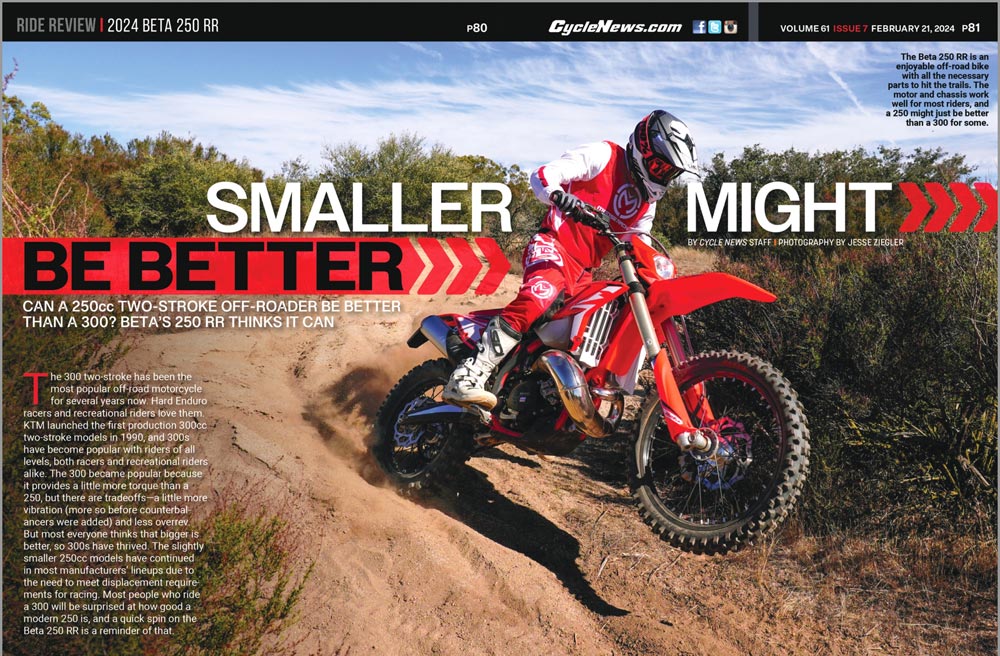Cycle News Staff | February 28, 2024
The 300 two-stroke has been the most popular off-road motorcycle for several years now. Hard Enduro racers and recreational riders love them. KTM launched the first production 300cc two-stroke models in 1990, and 300s have become popular with riders of all levels, both racers and recreational riders alike. The 300 became popular because it provides a little more torque than a 250, but there are tradeoffs—a little more vibration (more so before counterbalancers were added) and less overrev. But most everyone thinks that bigger is better, so 300s have thrived. The slightly smaller 250cc models have continued in most manufacturers’ lineups due to the need to meet displacement requirements for racing. Most people who ride a 300 will be surprised at how good a modern 250 is, and a quick spin on the Beta 250 RR is a reminder of that.
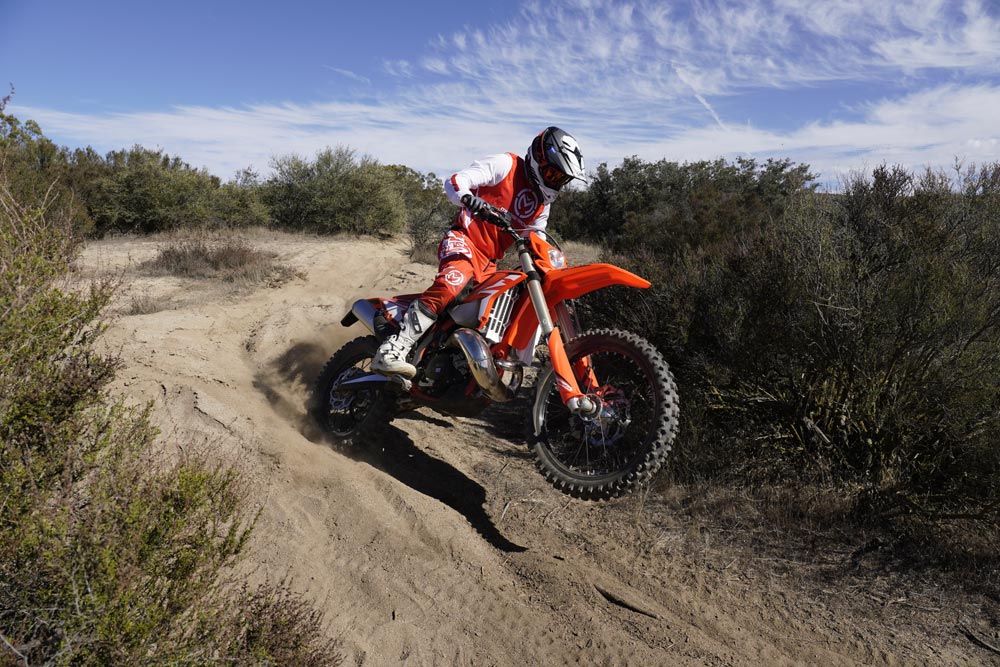 The Beta 250 RR is an enjoyable off-road bike with all the necessary parts to hit the trails. The motor and chassis work well for most riders, and a 250 might just be better than a 300 for some.
The Beta 250 RR is an enjoyable off-road bike with all the necessary parts to hit the trails. The motor and chassis work well for most riders, and a 250 might just be better than a 300 for some.
Photography by Jesse Ziegler
2024 Beta 250 RR
We rode the 2024 Beta 250 RR in a wide range of terrain, including single-track trails in the woods and open deserts, and found it incredibly capable and fun. And dare we say, it could be even better than its 300cc sibling for many riders.
The 250 RR has a suggested retail price of $9899. It features an electric start (optional kickstarter back up), a six-speed transmission, 36mm Keihin carburetor, oil injection, a 2.5-gallon translucent fuel tank, a headlight, a plastic skid plate, an 18-inch rear wheel, a two-position map switch, an enduro computer and Sachs suspension. You will likely want to add some handguards and possibly a radiator fan and some more guards if you plan to get rowdy, but otherwise, the Beta RR models come with all the essential parts needed for off-road riding. Beta offers the pricier $10,199 250 RR Race Edition that features upgraded KYB suspension, different engine settings, and some other cool enhancements, and that may be your best choice if you are into racing or pushing the pace a little more.
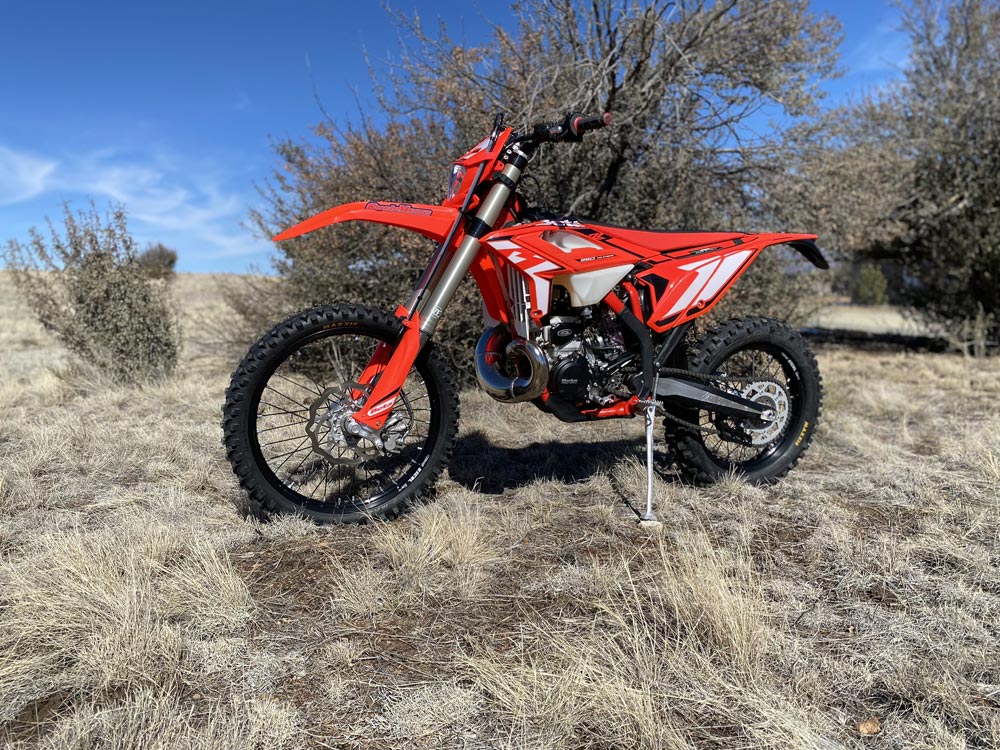 The standard Sachs suspension on the Beta RR line has steadily improved over the years.
The standard Sachs suspension on the Beta RR line has steadily improved over the years.
We have noted in past tests that the Beta RR models’ standard Sachs suspension has held back the bike’s performance on the trail, but Sachs continues to improve the settings and overall fork/rear shock action, and most recreational trail riders will be perfectly happy with the latest-generation RR suspension. Like most bikes, the Beta’s suspension needs to break in and will get better with time.
Our Beta 250 RR weighed in at 245 pounds with a full fuel tank, which is within a few pounds of other headlight-equipped off-road two-strokes on the market. The seat height is 36.6 inches, with 12.6 inches of ground clearance, similar to most other high-performance off-road bikes.
Beta used Michelin Enduro tires for several years and Metzeler tires in 2023, but our bike came with Maxxis MaxxEnduro tires, which worked well in the diverse terrain we rode the bike.
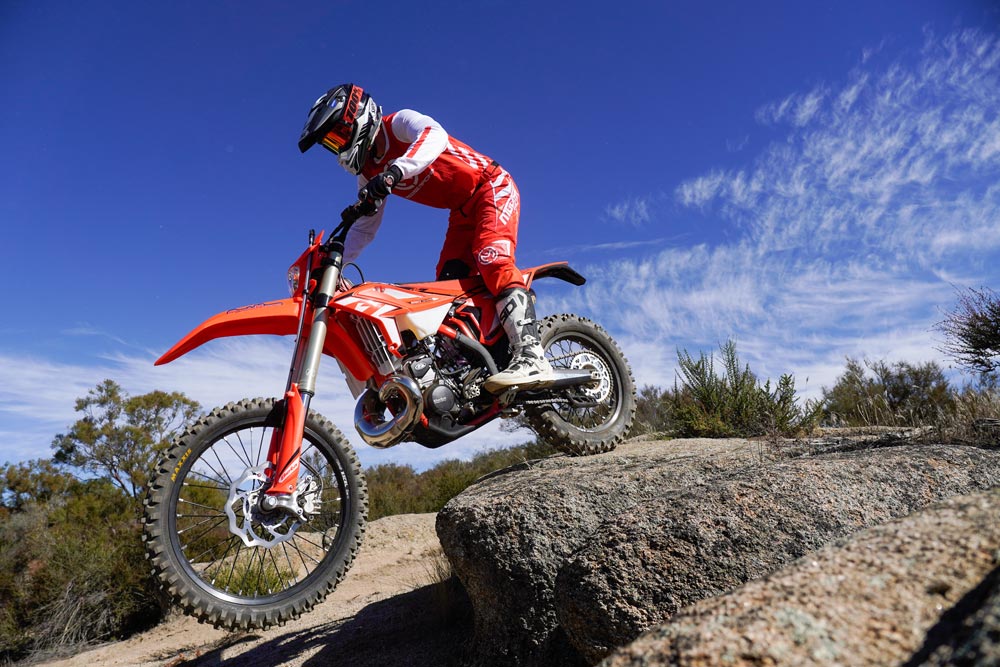 The Beta RR line comes standard with most of the parts you will want for trail riding. A headlight, skid plate, 18-inch rear wheel, and enduro computer are standard.
The Beta RR line comes standard with most of the parts you will want for trail riding. A headlight, skid plate, 18-inch rear wheel, and enduro computer are standard.
Trail Time | 2024 Beta 250 RR
We have noted before that—even though the Beta two-strokes have counterbalancers—you feel more vibration than on the KTM, Husqvarna and GasGas models. So, one of the benefits of the 250 versus 300 is the smaller piston translates to less vibration. Most people will gladly trade the vibration for more power, but that vibration adds to rider fatigue, and many riders are not using that extra power. And if you like to rev your bike, the 250 will keep pulling longer than a 300 between gears. We found this most noticeable on a fun turn track we found in the desert. You will certainly give up a little power for hill climbs, but it may be worth considering how much of that you do in your normal riding.
The Beta’s jetting is spot on with its Keihin carburetor, and like other Beta motorcycles we have ridden, it works well from sea level up to 5000-feet elevation. You can argue that fuel-injected bikes are more versatile, but carbureted Betas still perform exceptionally well. Unlike a fuel-injected bike, you will find some fuel leakage when tilted over on the trail, and you need to remember to turn the fuel tank petcock off when transporting the bike, or you could end up with an irritating fuel spill in your truck, van or trailer.
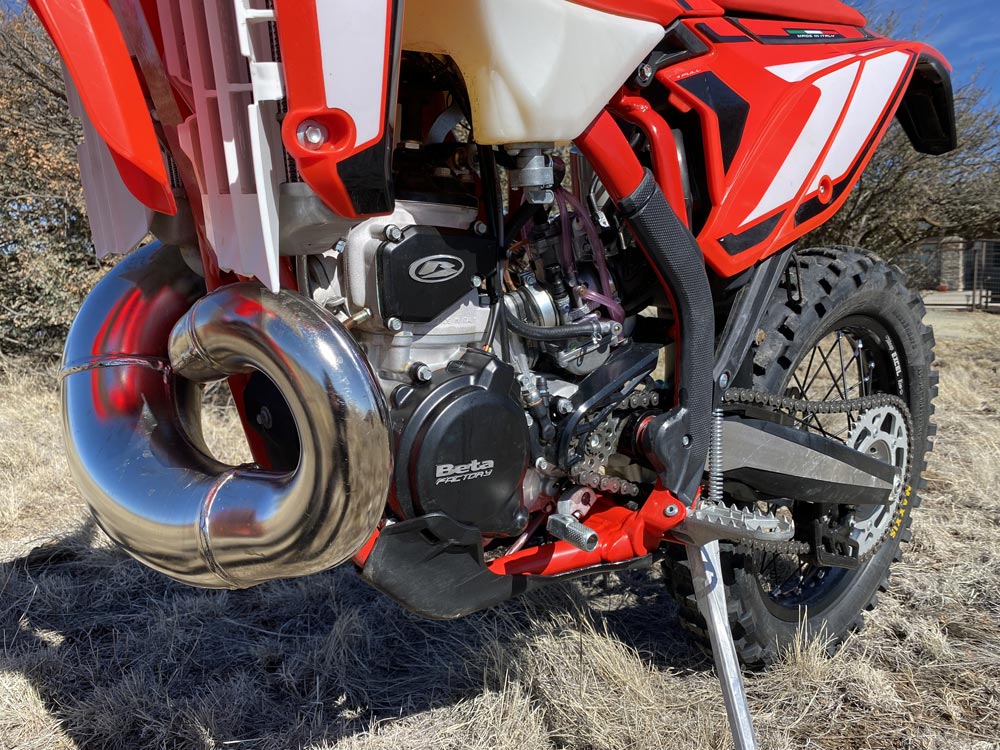 The 250 RR motor has plenty of power for most people, a little more overrev and less vibration than a 300, making it a better choice for some people.
The 250 RR motor has plenty of power for most people, a little more overrev and less vibration than a 300, making it a better choice for some people.
The two ignition maps make a noticeable difference on the 250, while we could hardly feel a difference on the 300s we have ridden lately. So that is nice, and you also have the option to adjust the powervalve spring preload, which can make a massive difference in the power delivery. Tightening the powervalve spring will keep the powervalve closed longer and mellow it out.
The clutch performance was good, with no issues. The hydraulic actuation is smooth and has a reasonably light pull. The same can be said for the Nissin brakes, which have plenty of power and are predictable.
We never had an issue with overheating on the 250 RR, but if you are taking on extra tough trails, we suggest adding a cooling fan. (Beta offers a fan kit for $210.) None of the Austrian 300 two-strokes come with a cooling fan either, however, models from the French manufacturer, Sherco, are fitted with cooling fans.
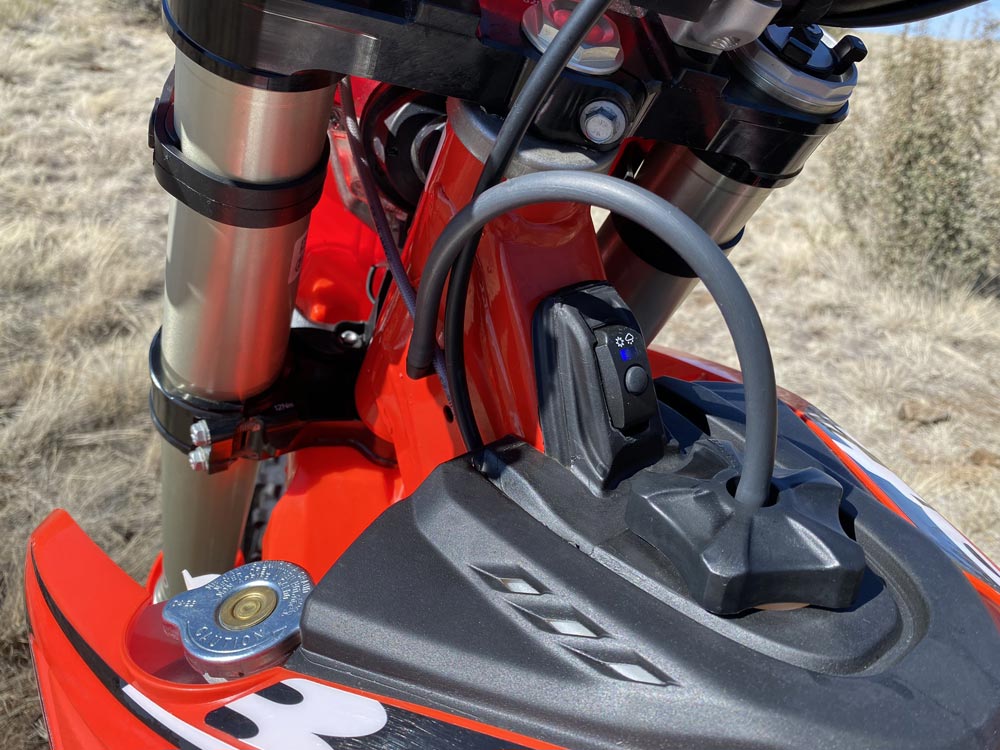 Rain or shine. The Beta has a map for both.
Rain or shine. The Beta has a map for both.
The Beta RR chassis is versatile and works well on tight trails in the woods. It also feels balanced and predictable in faster desert sections. Some test riders have noticed that the turning radius is slightly larger than that of other bikes in the class. The forks deflect a little in the rocks, but the shock performs well up to a fast, but not race, trail pace. Faster and/or heavier riders will probably be looking for suspension mods or may find it worth paying extra for the RR Race Edition model.
The 2.5-gallon tank delivers a similar range to any other bike in this class, although the fuel-pickup tube is relatively tall, resulting in the need to switch to reserve when there is a lot of fuel/range left in the tank. So, it gives you an early warning to look for fuel, and if you are racing, you would be wise to run it on reserve so you don’t “run out” at an inopportune time. The fuel tank petcock is positioned in a spot that can be hit by your boot, so you should keep an eye on that.
The chassis performs well at speed with confidence-inspiring stability. The 300 RR works well in slow technical terrain as well, but a few test riders that race hard enduro events noticed that the turning radius is a little greater than other bikes and requires some modification to the radiators to provide more clearance if you remove the steering stop bolts.
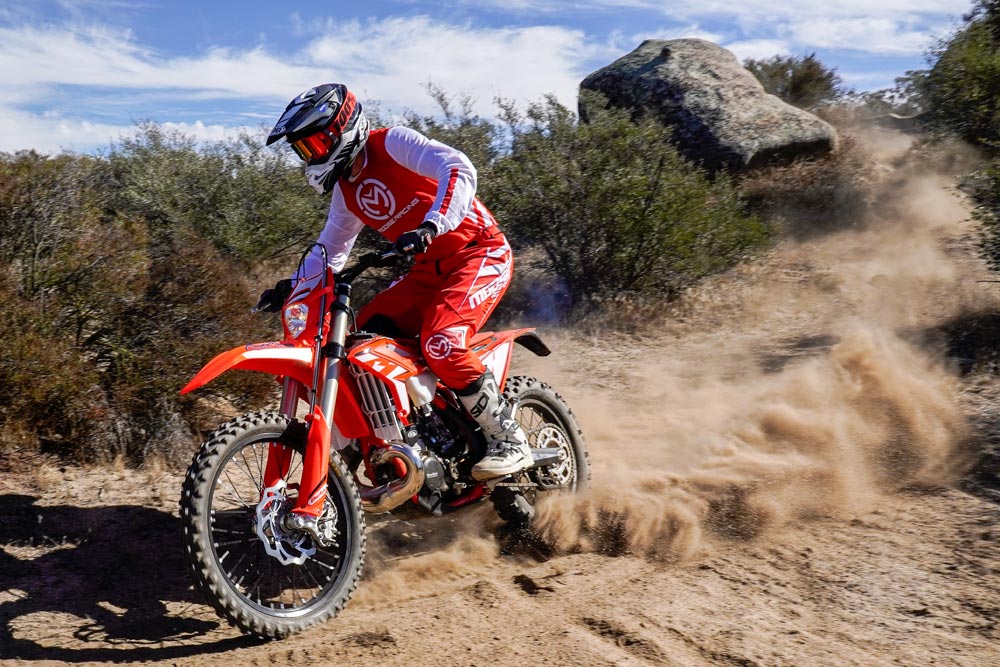 The Beta RR two-strokes use an oil injection system, so you don’t need to mix your fuel. The Race Edition models ditch that system in favor of weight, but we find that most trail riders prefer not to mix their fuel.
The Beta RR two-strokes use an oil injection system, so you don’t need to mix your fuel. The Race Edition models ditch that system in favor of weight, but we find that most trail riders prefer not to mix their fuel.
The ergonomics on the Beta are comfortable for all our test riders, but a few mentioned that the seat is a little uncomfortable after several hours of riding.
Betas are easy to work on because of their logical use of hardware and assembly. The tool-less seat removal and easy-access air filter are appreciated.
Betas continues to get good feedback on the styling. They have a clean design that most riders like, and they still generate a lot of comments from people at the track or trailheads.
If you are a racer who needs a 250 for a particular class, Beta has two great options: the 250 RR or the 250 RR Race Edition. Based on our experience with the Race Edition models, we feel that is the way to go for racers. If you are a trail rider looking for a fun bike that will provide solid performance, less vibration, and more over-rev, the 250 RR may be a better choice than even the more popular 300. CN
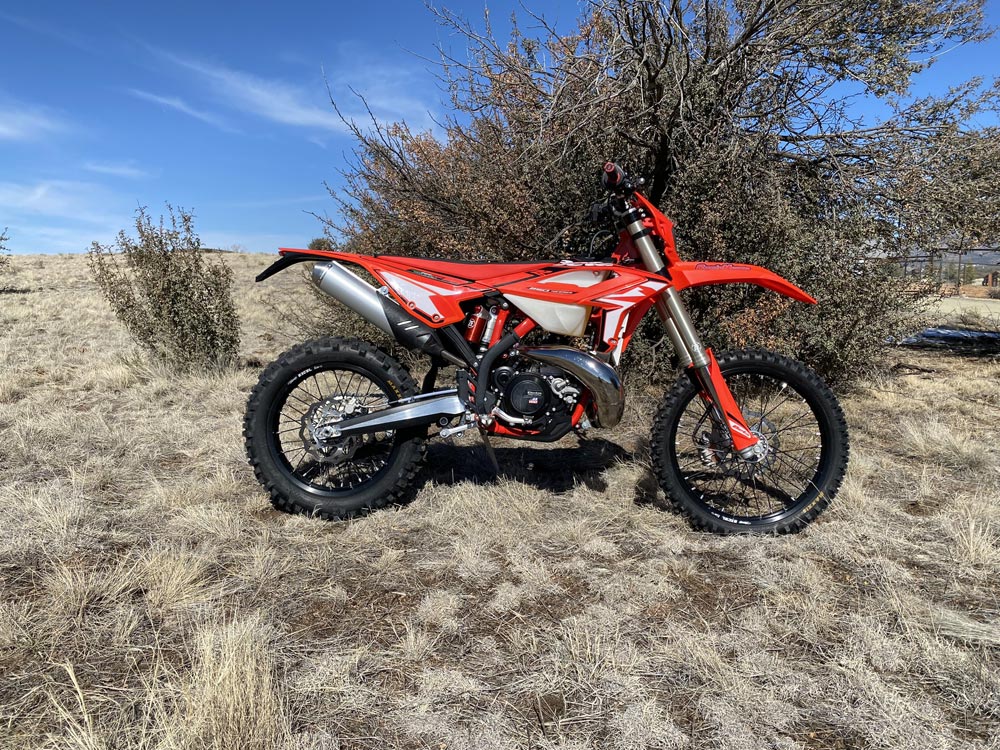
2024 Beta 250 RR Specifications
| MSRP: |
$9899 |
| Engine Type: |
2-stroke, single, adjustable powervalve |
| Cooling system: |
Liquid |
| Displacement: |
249cc |
| Bore x Stroke: |
66.4 x 72mm |
| Starting System: |
Electric (optional Kick Start backup) |
| Lubrication: |
Electronic Oil Injection |
| Fueling: |
Keihin PWK 36mm |
| Transmission: |
6-speed |
| Clutch: |
Wet multi-disc diaphragm-style clutch with hydraulic actuation |
| Frame: |
Molybdenum steel perimeter double-cradle-type |
| Front Suspension: |
48 mm Sachs Open Cartridge with compression, rebound & Ignition spring preload adjustment |
| Rear Suspension: |
Aluminum Body Sachs shock w/ adjustable rebound and hi/low speed compression |
| Front-Wheel Travel: |
11.6 in |
| Rear-Wheel Travel: |
11.4 in |
| Front Wheel: |
21 in. |
| Rear Wheel: |
18 in. |
| Front Tire: |
90/90 x 21 Maxxis MaxxEnduro |
| Rear Tire: |
140/80 x 18 Maxxis MaxxEnduro |
| Front Brake: |
260mm floating rotor, Nissin master cylinder and caliper |
| Rear Brake: |
240mm, Nissin master cylinder and caliper |
| Seat Height: |
36.6 in. |
| Ground Clearance: |
12.6 in. |
| Wheelbase: |
58.3 in. |
| Fuel Capacity: |
2.5 gal. |
| Weight (full fuel, measured): |
245 lbs. |
